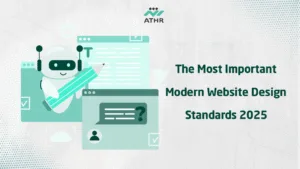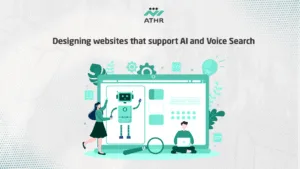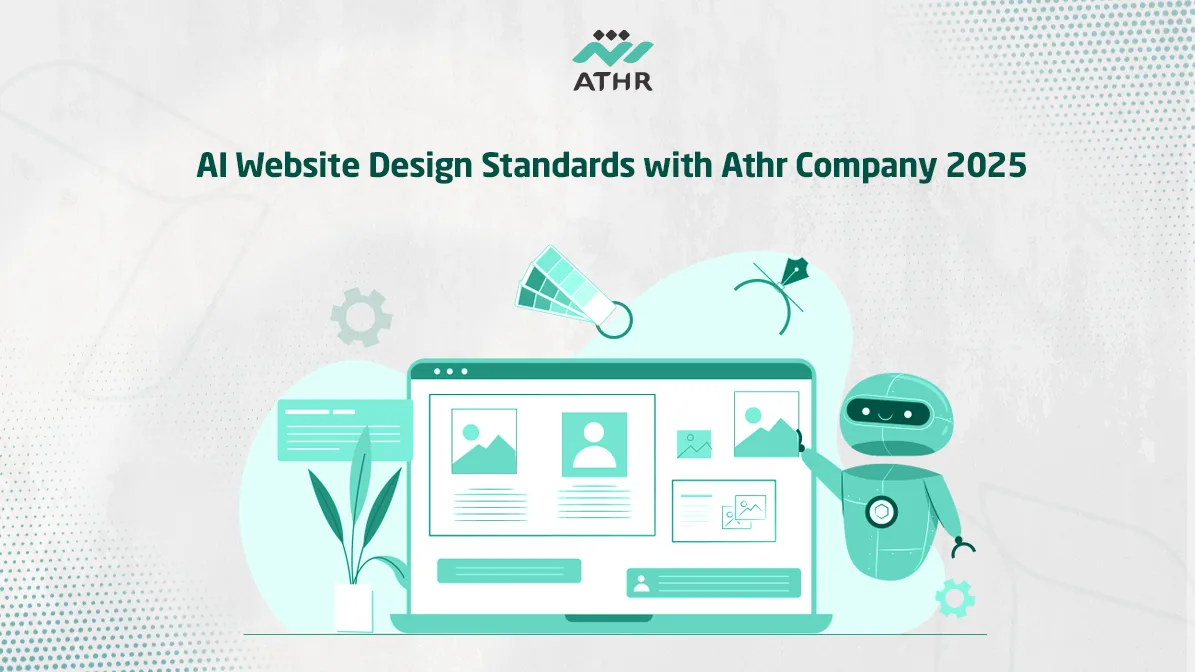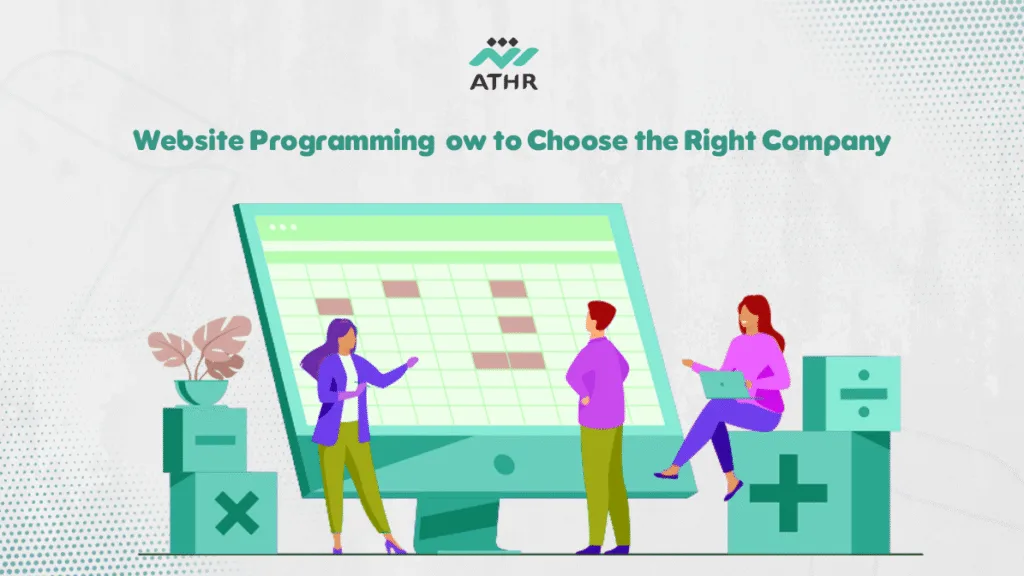Beautiful design is no longer enough; Artificial Intelligence (AI) has become the secret ingredient behind successful websites. Modern sites do not merely display content; they “think” and interact with the user to provide a personalized, fast experience.
We will review the most important AI website design standards and how you can leverage them to make your site smarter, more interactive, and compatible with future technologies.
Every great idea deserves a smart website —📞Talk to the Athr team today and start the implementation.
جدول المحتوي
- How Does AI Contribute to Modern Website Design?
- 🚀The Most Important Modern Website Design Standards 2025
- ⚙️The Impact of AI on Website Speed and Performance
- Designing Websites That Support AI and Voice Search
- What is AI-compatible website design?
- Why do I need a website that uses AI?
- How does AI improve site speed and performance?
- Is designing an AI-compatible website expensive?
- How do I prepare my site for voice and AI search?
- Can my site automatically interact with visitors?
- What is the best company for designing AI-compatible websites?
How Does AI Contribute to Modern Website Design?
AI in website design has become the cornerstone for developing smarter and more flexible websites. It is not limited to improving the general appearance but extends to understanding user behavior and offering a personal experience that evolves with every visit.
🎯Analyzing User Behavior and Automatically Personalizing Content
One of the most significant advantages of AI in website design is its ability to understand user behavior in real-time. By analyzing data such as browsing duration, most visited pages, and even mouse movements, the system can deliver customized content for every visitor.
For example:
- If the site notices that a user is interested in the Services pages, it will automatically show them related offers or templates.
- If they are browsing from a mobile device, the design will be rearranged for a faster and smoother experience.
📌 This type of smart personalization increases engagement and multiplies the opportunities for sales or customer contact.
That is why Athr Programming and website Design Company relies on AI-powered solutions that guarantee a personalized and unique experience for every client.
💡Using AI to Enhance User Interface (UI) and User Experience (UX)
User Interface (UI) and User Experience (UX) are the two elements that determine the success of any website. AI here is not just used for suggesting colors or arranging elements, but for analyzing the entire user journey and identifying points that need improvement.
Some modern techniques include:
- Automated UX Testing to discover interaction issues before the site launch.
- Eye Tracking analysis to determine the elements that capture the user’s attention most.
- Dynamic designs (Adaptive Layouts) that automatically adjust to the visitor’s actions.
All these tools translate into a more seamless experience and greater user satisfaction, which directly reflects in improving the Dwell Time and raising the site’s ranking in search results.
🧩Artificial Intelligence (AI) Tools Assisting in Website Design
Today, the designer no longer works alone; there are smart assistants providing immediate support at every stage of site development. Among the most prominent of these tools are:
- ChatGPT – Helps in creating customized website content and optimizing texts to align with Search Intent.
- GitHub Copilot – Used to generate clean, standard-compliant code without the need to write everything manually.
- Google Gemini – A powerful tool for data analysis and predicting user behavior, which helps in improving future browsing experiences.
📌 By using these tools together, programming companies like Athr can build sites that are smarter, faster, and more effective, meeting user expectations and outperforming competitors.
Discover the secrets to choosing the perfect programming company! 👇
🔗 Website Programming | How to Choose the Right Company
🚀The Most Important Modern Website Design Standards 2025

The world of website design is witnessing a radical transformation. Websites are no longer designed based solely on aesthetic appeal but according to performance and experience standards powered by Artificial Intelligence (AI).
The most prominent standards that Athr Company focuses on in its website designs are:
- Smart Behavioral Analysis: To understand visitors’ needs and predict what they are searching for.
- Dynamic Design: Which automatically adapts to the device, internet speed, and user behavior.
- Superior Performance: Where page loading time is a crucial factor in attracting or losing a visitor.
- Continuous Improvement: Thanks to AI algorithms that learn from interaction and self-develop the website.
These combined elements turn your site into a smart platform that grows automatically and achieves tangible marketing results without constant manual intervention.
⚡ Speed, Interaction, and Personalized User Experience
Speed has become the first standard of success in AI-compatible website design.
📈Statistics indicate that 53% of users leave a site if it takes more than 3 seconds to load. Therefore, leading companies today use Artificial Intelligence (AI) techniques to minimize code size, automatically adjust images, and enhance server performance.
As for interaction, it is no longer just clicks or buttons, but an integrated experience that includes smart conversations, automatic suggestions, and virtual assistants that communicate with the visitor in real-time.
📱Design Compatibility with Devices and Smart Search Technologies
In the era of AI search and voice assistants like Siri and Google Assistant, it has become essential for a website to be understandable and interactive via voice commands. This is why designing websites that support AI search has become a fundamental standard in every successful digital project.
💡Here are the main points Athr Company focuses on in this regard:
- Fully Responsive Design: Ensures the site displays perfectly on all devices and screens.
- Structured Data: Helps Google understand the site content and present it in smart search results (Rich Snippets).
- Voice Search Optimization: By using natural phrases like “How do I find…” or “What is the best web design company…?” to match the user’s voice search intent.
- Seamless User Experience (UX Flow): Enables the user to reach their goal with the fewest possible clicks.
In this way, your site becomes friendly to both traditional search engines and predictive AI at the same time.
📊 The Role of Data and Analytics in Improving Visitor Experience
AI doesn’t stop at website design but extends to analyzing its performance instantaneously. Smart analysis algorithms collect data on user actions, such as:
- Most visited pages.
- Exit rate from each page.
- Devices and operating systems used.
This data is then translated into smart recommendations that help improve the design and content. For example, if the system discovers that visitors are leaving at a specific step, it will suggest modifying the interface or element arrangement to enhance interaction.
⚙️The Impact of AI on Website Speed and Performance
A few seconds can determine the fate of your website — either attracting the visitor or losing them forever.
Studies show that every one-second delay in page loading can reduce the conversion rate by 7%, a huge number when it comes to sales or leads.
Therefore, relying on AI website design has become a necessity for every company striving to provide superior performance and a distinctive user experience.
⚡ How Does AI Contribute to Improving Page Load Time?
AI operates much like a smart speed engineer — it monitors every movement within the site, analyzes every file, and then makes immediate decisions to enhance performance.
The most prominent ways it contributes to accelerating websites are:
- Automatically compressing images and media without affecting quality, using algorithms like AI Image Optimization.
- Smart Caching based on visitor behavior to reduce recurring server requests.
- Analyzing code and detecting unnecessary redundancies (Code Minimization).
- Dynamically distributing content across networks (CDN Optimization) to deliver pages from the closest location to the user.
🌐The Relationship Between Performance Improvement and User Experience in Smart Websites
Site performance and speed are not just technical figures — they are the foundation upon which the user experience is built. When a user opens your site and finds that it responds instantly, they feel confidence in your brand and spend more time browsing.
AI enhances this experience by:
- Predicting visitor behavior to deliver content before it’s requested.
- Automatically adjusting element order to show the most important things first, based on user interaction.
- Analyzing Core Web Vitals (like LCP, FID, and CLS) and improving them automatically.
- Customizing performance for each user based on their device and internet connection speed.
In this way, the site becomes smarter and more capable of retaining the visitor and converting them into an actual customer.
🔍Quick Facts:
- Faster websites achieve a 70% higher retention rate.
- Over 80% of users prefer dealing with sites that provide an immediate response.
- Google prioritizes ranking for sites that achieve the best Page Experience Signals.
🧠AI Tools for Performance Monitoring and Real-Time Results Analysis
Continuous analysis is the secret to the superiority of smart websites. AI doesn’t just speed up the site but monitors its performance in real-time and suggests precise improvements based on data.
The most prominent AI tools for website development and monitoring are:
- Google Lighthouse AI – For analyzing performance and user experience according to modern Google standards.
- New Relic AI Monitoring – Monitors faults as they occur and suggests self-healing solutions.
- Cloudflare Insights – For improving security and performance through machine learning algorithms.
- DeepCrawl AI – For inspecting the site’s code structure and discovering hidden technical errors.
These tools give you a comprehensive vision of your site’s performance and help you make informed development decisions based on real data.
Don’t leave your website vulnerable to attacks! Discover 10 tips to secure websites against hacking in Saudi Arabia.
🔗 Read the article
Designing Websites That Support AI and Voice Search

The user no longer types in the search bar, but talks to the internet. From “Hey Google” to “Siri” and “Alexa,” voice search and AI technologies have become the preferred way for users to find what they want quickly and accurately.
If you seek to place your site at the forefront of smart search results, you must start now by optimizing it to interact with Artificial Intelligence — and not just with traditional search engines.
How to Make Your Site Compatible with Voice and Visual Search?
AI has radically changed the way users search. Searching no longer relies solely on typed words but on voice commands and visual search, which uses images or the camera to reach results.
Here are the main steps Athr Company adopts to design AI-compatible websites: 👇
- Site Speed Optimization: Because the voice user expects an immediate response, and any delay reduces your chances of appearing in smart assistant results.
- Focusing on Natural Questions: Such as “How can I create a website?” or “What is the best web design company in Saudi Arabia?” — this is the language AI understands.
- Using Structured Data: To enable search engines to clearly read the site’s content and understand its context.
- Including Visual Search: By supporting high-quality images and accurate descriptive tags (Alt Text) that help Google Lens and Pinterest AI recognize your products or services.
- Mobile Optimization: Because more than 70% of voice searches are done via mobile.
💬 Optimizing Content to Respond to Users’ Questions in a Conversational Format
Content is the heart of AI search. Smart assistants like ChatGPT or Google Bard look for direct and smooth answers — resembling a human conversation style. Therefore, your articles and site pages should be written in natural language and a conversational style that clearly answers user questions.
🔹How you can optimize content for this:
- Use phrases starting with “How,” “What is,” and “Why” — as they are most used in voice search.
- Add concise and clear answers within each paragraph (Snippet Style).
- Keep paragraphs to no more than 3 sentences to maintain the reader’s focus.
- Use natural, conversation-like sentences such as: “Did you know that…?” or “Imagine you are looking for…”.
- Include Long-tail Keywords in the form of questions like:
- How can I design an AI-compatible website?
- What are the voice search tools in modern websites?
In this way, your content becomes compatible with the new Google updates and is directly displayed in “Featured Snippets” and interactive SGE results.
Tips for Optimizing Your Site for Google’s SGE Technologies
Today, Google is working on integrating Search Generative Experience (SGE) into search results, a feature that displays smart and comprehensive answers based on content analysis, not just keywords.
For your site to appear in SGE results, you must follow these standards:
- Focus on Value and Quality: Google no longer favors long articles only, but those that provide accurate, source-supported answers.
- Reliance on Real Experience (E-E-A-T): Show your expertise in the field through real-world examples or projects you have executed.
- Using AI for Text Analysis and Optimization: Such as ChatGPT and Gemini tools to improve phrasing and discover the best keywords.
- Adding FAQ Schema and HowTo Schema: To make it easier for generative search engines to understand the article structure.
- Optimizing Images and Videos: Because Google SGE relies on displaying smart media alongside texts.
Website design in 2025 relies on Artificial Intelligence to deliver a smarter and easier user experience. If your site is still traditional, now is the right time to develop it and keep pace with the future.
Take a simple step towards a smart, fast website that reflects your project’s identity and increases your digital success.


